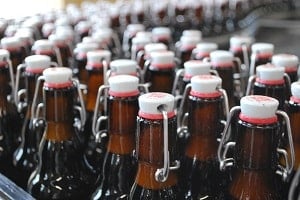Homebrewers know that beer yeast can get expensive if you brew beer often. Reusing the leftover yeast from brewing can save both time and money if you know what to do with it.
Use leftover beer yeast in a variety of ways so that all the nutrient-rich goodness doesn’t go to waste. Use it to make a new batch of beer or to make beer bread, pretzels, pizza crust, marmite, Kvass, and Kombucha. You can even use leftover beer yeast to jumpstart your compost pile.
Read on to find out more about these options for using leftover beer yeast.
Topics We Cover
The best things to do with leftover beer yeast
Leftover beer yeast is the slurry left in the trub after fermentation. You can reuse it and any unused yeast starter you may have on hand. Making a new starter is the obvious choice to get more mileage from your yeast. If you’re feeling adventurous, you can also try some of the creative options below.
- Reuse for Beer
- Beer Bread
- Pretzels and Pizza Crust
- Marmite
- Kvass
- Kombucha
- Compost
Reuse for Beer
You can reuse leftover yeast at least 3 or 4 times without worry so long as it remains healthy.
To reuse your leftover yeast in a new batch of beer, first, wash the yeast using the method below. Swirl the jar to incorporate the yeast on the bottom of the jar. Pour the amount needed to make your yeast starter into a sterilized measuring cup, and continue with your starter recipe.
Washing Yeast Before Reuse
Many brewers wash leftover yeast to remove strong flavors and excess bitterness. It’s also the best way to remove the debris from the trub.
To wash leftover yeast, first clean and sterilize all the equipment you’ll need. Add a half-gallon of distilled water to the trub and swirl to remove the sediment on the bottom.
Pour the mixture into a clean carboy or another pourable container, and if possible, turn it on its side. Let the mixture settle for at least 30 minutes. You’ll see three layers once the mixture has settled. Decant the top two layers of liquid which contain the yeast into a new, clean carboy or container, and lay on its side.
Let the mixture settle again for 1 – 2 hours without disturbing it. Patience is important with this process to ensure that any trub is settled on the bottom. After the second rest, decant the top layer of yeast liquid into four sterilized canning jars.
Don’t over-tighten the lids on the jars. Leave them a little loose so that any gas that builds up can escape. Store the jars in the refrigerator. After a week or so, you can tighten the lids down. The washed yeast can be stored for a few weeks with no issues.
Use the washed yeast to make a new starter to pitch for your next brew, or store it to use later. Write the type of beer the yeast came from on the starter label so it can be used to brew a similar beer in the future.
Read this step-by-step guide for instructions to harvest, wash, store, and sanitize yeast.
Beer Bread
Almost everyone has made some version of bread by pouring beer into the dough. You can also make flavorful bread with leftover beer yeast. Brewer’s yeast and baker’s yeast have different properties. Use a recipe like sourdough for the best bread texture.
Wash the yeast as noted above to remove some of the bitterness from the grains and hops. Make a bread starter with the beer yeast, flour, and sugar. Let it sit overnight until bubbly on top, then add the starter to a basic bread dough recipe.
This recipe at Delishably uses yeast from the trub to make a sourdough-like bread.
Pretzels and Pizza Crust
Use washed leftover yeast to make soft, golden pretzels and pizza crust. Beer yeast doesn’t give off as much CO2 as baker’s yeast, so it doesn’t rise as fast. The dough will need a much longer time to rise than bakers’ yeast to ensure the best texture.
Add some leftover yeast to a basic pretzel or pizza crust dough in place of dry active baker’s yeast. Be sure to adjust the water in the recipe if you’re using slurry instead of dry yeast.
This homebrewer’s thread has a soft pretzel dough recipe that uses leftover beer yeast. Bertus Brewery also has a delicious, crispy, chewy pizza crust recipe made with trub yeast slurry.
Marmite
Marmite is a British spread made from yeast extract, vegetables, and spices. It’s usually served on toast. Like its Australian cousin Vegemite, it’s an acquired taste, especially for Americans.
Boil the washed yeast and strain it through a cheesecloth. Let it settle overnight and strain again while boiling the vegetables until they’re soft. Drain the vegetables and mix them into the yeast paste. Spread the mixture into a large baking pan and bake until most of the liquid has evaporated.
If you’re brave enough to try this unique spread, Ms. Marmite Lover has an interesting recipe on her website. Remember to spread the Marmite thinly on bread or toast, not like you would peanut butter. It has a very strong, salty taste and a little goes a long way.
Kvass
Kvass is a very old recipe enjoyed in the Slavic countries of Eastern Europe. Kvass is a carbonated soda made from fermented berries, herbs, yeast, and bread. The combinations of ingredients you can use to flavor it are endless.
To make Kvass, toast bread chunks until golden brown. Briefly boil the toasted bread with water, sugar, berries, and spices. Cool the mixture by placing the pot in cold water. Once cooled, add the leftover beer yeast, then cover the pot with a lid or transfer to a container with an airlock. Let the mixture ferment for 8 – 12 hours, then strain into bottles.
Check out some tempting recipes at Chelsea Green’s website to try this ancient brew.
Kombucha Beer
If you’re willing to experiment, you can use leftover beer yeast to make Kombucha beer. Most brewers agree that making Kombucha beer is all about trial and error.
To make Kombucha beer, add barley, hops, molasses, sugar, and leftover beer yeast to the Kombucha’s second fermentation.
Try this complete Kombucha beer recipe from Daniel Klein on Kombucha Home’s website.
Compost
Add leftover beer yeast to your compost pile. Beer yeast speeds decomposition by raising the temperature of the pile. It also attracts slugs and worms whose activity in the pile is beneficial.
Pour leftover yeast slurry on your compost pile and add dried leaves, pine needles, wood ash, or other carbon-rich materials. Turn the pile after adding the yeast to mix it with the other materials and add oxygen.
You can also add spent grain to your compost pile. Be sure to turn the pile to mix them in since they can give off a strong smell while decaying.
I’ve also written up a guide on what to do with leftover (or bad) beer if you want to check it out!





